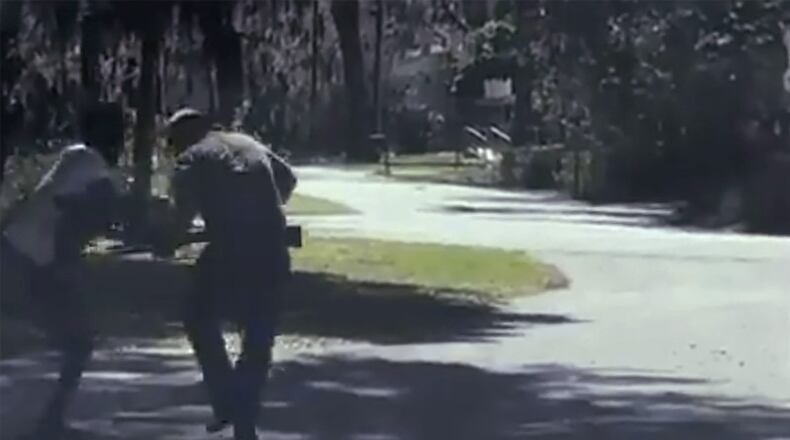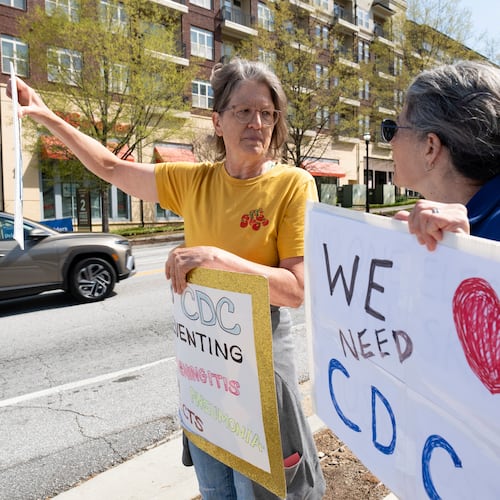News reports repeatedly say Ahmaud Arbery was trying to avoid the two men who had formed an impromptu posse.
That’s not exactly true. A video of the 25-year-old Brunswick man’s final moments shows Arbery coming fast around the front of the pickup truck and upon the shotgun-toting Travis McMichael in an instant, perhaps three or four quick steps.
It immediately became a life-or-death struggle where life stayed with McMichael and death came to Arbery.
He was wrong.
The video of the incident, released this week, instantly exploded across the world and even entered presidential politics as Joe Biden said, "The video is clear: Ahmaud Arbery was killed in cold blood."
The video may not be quite as clear as “Uncle Joe” has posited. The legal question remains whether Travis McMichael and his father, Greg McMichael, should have armed themselves and chased Arbery, who is black. But it sure doesn’t look good for the McMichaels, who are white. The father is a former cop and district attorney’s investigator who was in the law enforcement game for nearly 40 years, long enough to know better.
The two were charged with murder on Thursday, just days after the video was released. Once again, it shows the power of grainy images.
The case was initially punted by Glynn County District Attorney Jackie Johnson, who had worked with the elder McMichael for years and found herself in a conflict. She is also good at miscarrying justice, as witnessed by her inaction in the case of the late murderous cop Robert C. Sasser.
The Arbery case, which occurred in late February, first went to Waycross District Attorney George Barnhill, who studied the killing and then reduced his unofficial opinion to writing before pulling the ripcord and bailing on this case.
In his opinion before leaving, Barnhill opined in a letter to the Glynn County police that the McMichaels should receive a Stay Outta Jail card.
» CONTINUING COVERAGE: AHMAUD ARBERY DEATH
Barnhill saw the video that everyone else has seen the past few days and deemed it a good killing. He said the McMichaels and a third party, William Bryan, the guy who shot the video from his vehicle, “were following in ‘hot pursuit’ (a) burglary suspect, with solid first-hand probable cause in their neighborhood and asking/telling him to stop.”
Of the killing, Barnhill wrote, “Given the fact Arbery initiated the fight, at the point Arbery grabbed the shotgun, under Georgia Law, McMichael was allowed to use deadly force to protect himself.”
Aside from the racial issue here, the case smells like law enforcement initially trying to give one of their own a break.
There may have been a theft (or even more than one) in the neighborhood in recent weeks, and when the elder McMichael saw a black man jogging past, he figured he looked like the guy seen earlier in some neighbor’s surveillance video. Afterward, McMichael told the cops that Arbery was “hauling ass,” which makes it sound like someone trying to escape.
But perhaps he was merely jogging, which Arbery often did. One might wonder why a black man dressed in a T-shirt and running shorts would come to a white neighborhood in broad daylight at 1 p.m. on a Sunday, a time when most people are home, and think he’d get away with much.
Someone called 911 to say they saw a black man enter a house under construction. The dispatcher initially seemed nonplussed. “I just need to know what he was doing wrong,” the dispatcher said.
I must admit that I, like many nosy people, have entered houses under construction to peek about. A reporter I spoke with said there is absolutely nothing in that house to steal. Perhaps the jogger made a pee stop.
Nonetheless, the McMichaels, being can-do fellows, gave chase.
According to the Brunswick News, only one burglary was reported in the neighborhood in the two months before the shooting — a 9 mm pistol was stolen from outside the home of Travis McMichael. (Side note: If you are having guns stolen from your car, you are a big part of the crime problem.)
In mid-April, the Arbery case was handed over to Hinesville District Attorney Tom Durden. This week, after the video of the shooting was released and shock waves reverberated, Durden announced he would bring the case to a grand jury. This came around the time that Gov. Brian Kemp and Attorney General Chris Carr issued statements that justice must be done.
Then on Thursday, the announcement of charges came.
Hours before, Gwinnett County prosecutor Danny Porter said, “There are some questions I want answered, mainly, on what justification did they pursue the guy on the street? If it wasn’t justified, then they have a problem.”
Porter added that he has kept up with the case and has seen the video. “To me, that does not look like self-defense.”
J. Tom Morgan, former DeKalb County district attorney, said, “I cannot start an incident and escalate it to defend myself.” If you are trying to make a citizen’s arrest, the crime must have been committed in your presence, he said.
Morgan, who is now a law professor, trotted out a 1920 Georgia Supreme Court case that explored issues eerily similar to this: citizens' arrest and self-defense. That case concerned two private citizens convicted of murder for shooting a man they thought, wrongly, was involved in an aggravated assault.
The case found that “a private citizen has as much right to arrest a fugitive felon, where the emergency calls for immediate action.” And that person “has the right to use such force as may be necessary to compel submission and accomplish the arrest and is not bound to wait until he is actually assaulted before resorting to force.”
However, the court in that case ruled against the men, saying, “A person cannot create an emergency which renders it necessary for another to defend himself, and then take advantage of the effort of such person to defend himself in the face of such emergency so created, and justify the taking of the life of such person.”
Sounds like a century-old echo.
About the Author
Keep Reading
The Latest
Featured





